I’ve been reading through undergraduate textbooks, trying to figure out where the idea that money base expansion must necessarily manifest itself in higher inflation. In Stephen Williamson‘s macro textbook, he argues that fears of inflation are motivated by the view that eventually, money base expansion will feed into money expansion (box on pp. 432), despite the fact that there is no obvious contemporaneous correlation between the two variables.
I would’ve agreed with that assertion in a world where no interest was paid on reserves (see here for a primer). However, even the M2 to inflation link is less than entirely convincing of a money-inflation link at the short horizon. [1] In any case, here are some scatterplots. First, 3 month changes (in log terms):

Figure 1: 3 month log difference in CPI (all) against 3 month log difference in money base, not seasonally adjusted, 1967M01-2010M10. Source: St. Louis Fed FREDII. Money base is BOGUMBNS.
These are overlapping observations. The observations in the lower left right hand side quadrant pertain to period of quantitative easing. The next two graphs eliminate overlapping changes, and then the post-Lehman observations.
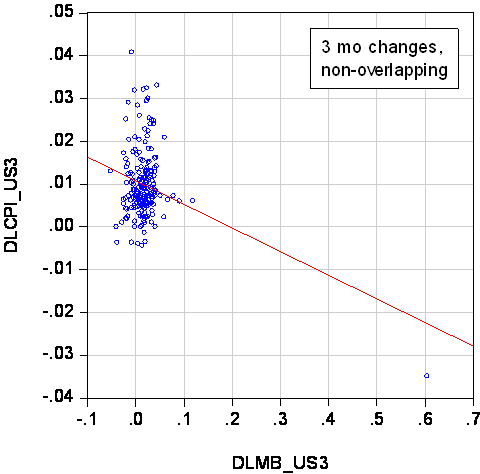
Figure 2: Nonoverlapping 3 month log difference in CPI (all) against 3 month log difference in money base, not seasonally adjusted, 1967M01-2010M09. Source: St. Louis Fed FREDII. Money base is BOGUMBNS.
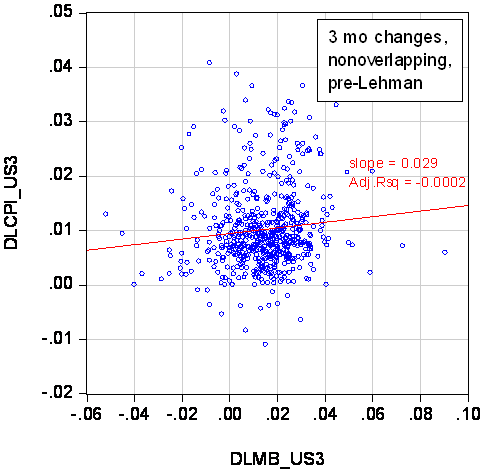
Figure 3: Nonoverlapping 3 month log difference in CPI (all) against 3 month log difference in money base, not seasonally adjusted, 1967M01-2008M06. Source: St. Louis Fed FREDII. Money base is BOGUMBNS.
Note that a positive correlation only shows up in this third figure. However, almost none of the variation in inflation is explained by money base growth.
Professor Williamson appeals to lags as a reason to worry about money base expansion. In the next two graphs, I plot 12 month changes, both contemporaneous, and with money base growth lagged one year.
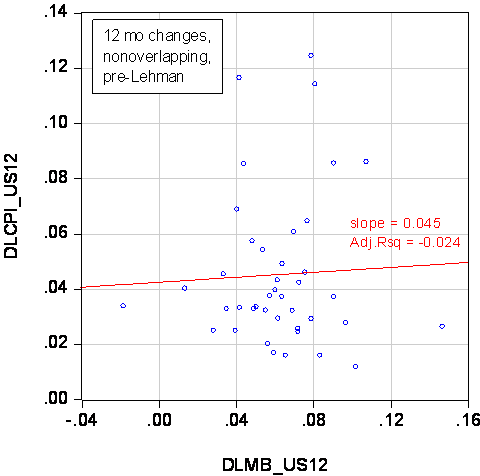
Figure 4: Nonoverlapping 12 month log difference in CPI (all) against 12 month log difference in money base, not seasonally adjusted, 1967M01-2007M12. Source: St. Louis Fed FREDII. Money base is BOGUMBNS.
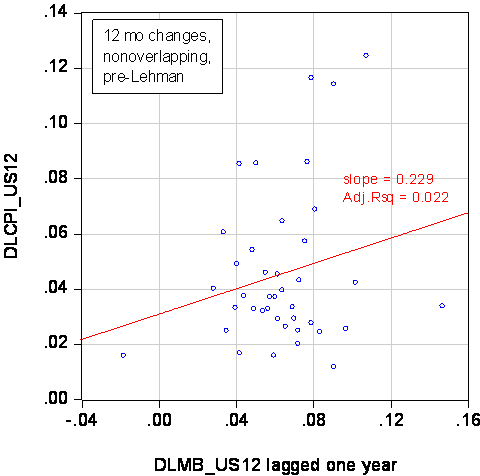
Figure 5: Nonoverlapping 12 month log difference in CPI (all) against 12 month log difference in money base, not seasonally adjusted, 1967M01-2007M12. Source: St. Louis Fed FREDII. Money base is BOGUMBNS.
There does appear to be a positive correlation, although the slope coefficient p-value is 0.177, and the adjusted R2 is negative. Even this result is sensitive to slight modifications. If one normalized money base by some scale variable, like industrial production, then essentially none of the variation in inflation is explained by the growth rate of money base.
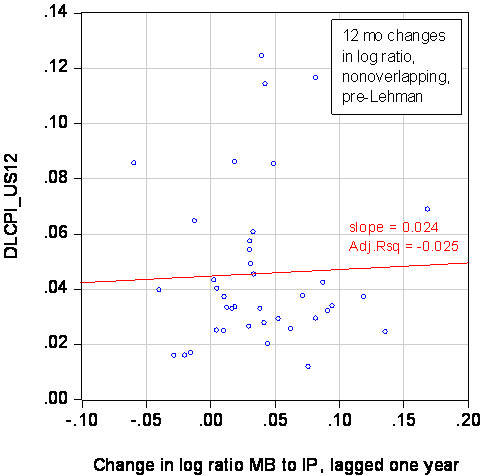
Figure 6: Nonoverlapping 12 month log difference in CPI (all) against 12 month difference in log ratio of money base, not seasonally adjusted, to industrial production, 1967M01-2007M12. Source: St. Louis Fed FREDII. Money base is BOGUMBNS.
Combine the above with this St. Louis Fed article on the various other national QE episodes, and I still wonder exactly how QE2 is going to lead to high inflation.
Final observation: Here is what the data try to tell us is the relationship is, dropping linearity.
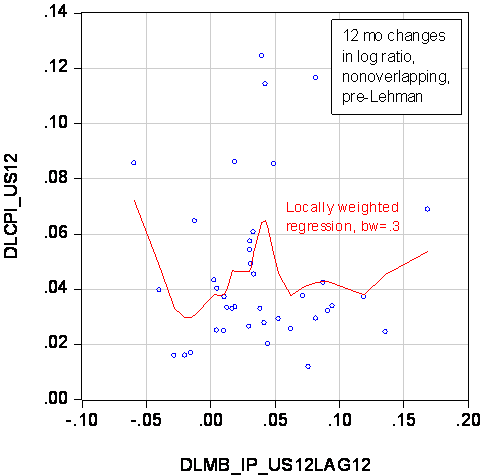
Figure 7: Nonoverlapping 12 month log difference in CPI (all) against 12 month difference in log ratio of money base, not seasonally adjusted, to industrial production, 1967M01-2007M12. Fitted line is locally weighted regression, nearest neighbor, bandwidth=0.3. Source: St. Louis Fed FREDII, and author’s calculations. Money base is BOGUMBNS.
ok great, why don’t we just increase the monetary base by the amount of the debt, say $13 trillion? or how about $50 trillion?
Stagflation is entirely missing from the Keynesian playbook. It’s as if the 1970s never existed.
The idea that excess reserves create inflation comes from the standard textbook example of the money multiplier. If excess reserves become loans then the money multiplier increases the money supply. Textbooks also demonstrate that a sustained increase in money growth leads to inflation.
You’re asking yourself the wrong question.
How might QE cause disinflation or deflation?
Prof. Chinn,
I find your empirically oriented analyses to be far more interesting than all the prose generated by many economics textbooks and authors.
The belief that inflation always results from monetary expansion is due to the uncritical acceptance of the oracular pronouncement: “inflation is always and everywhere a monetary phenomenon”.
Why bother with data when you can wallow in slogans ?
I don’t think anyone is arguing “that money base expansion must necessarily manifest itself in higher inflation.”
My argument is that we are running serial deficits around 10% of GDP with little political appetite for fiscal reform (check today’s tax-welfare deal!) and the central bank is brazenly monetizing the debt. Inflation seems a highly likely eventual outcome even if debt-deflation pressures keep a lid on inflation in the near term.
Those whose only tool is a macroeconomic model based on history will be helpless to understand this, as we’ve never been this far into uncharted waters before. Like the default modelers who never allowed for the possibility that house prices can go down, today’s macroeconomists who see no risk of inflation are in for The Shocker.
Remember, if a central bank is targeting inflation, absolutely nothing in the central bank’s information set should forecast inflation. That follows from rational expectations: inflation forecast errors around the constant target should be uncorrelated with anything in the information set.
Professor,
A recent article in the Wall Street Journal (“What Ben Bernanke May be Thinking”) says that the banks reserves might be used to lower the principle on mortgages, and that way, bailout the banks. Here’s the quote—-
“So, perhaps the Bernanke message here is for the banks to deploy those excess reserves to reset the value of their loan assets to current housing prices. They could do so by issuing new mortgages with lower principal amounts. While they would take short-term losses, this action could allay doubts about the value of the assets on bank balance sheets and would help the balance sheets of homeowners as well.”
Can the reserves actually be used like this? Could that be what Bernanke has in mind since QE doesn’t seem to really stimulate much of anything?
Of course its total money supply not monetary base that correlates with inflation… The 64 thousand dollar question is whether the FED will either shrink its balance sheet or erect tight reserve requirements to control credit expansion in the future.
Now and the Future has a good plot of M2/M3 vs CPI at http://nowandfutures.com/images/m2m3_cpi_money_supply1875.png
My opinion is that the FED will continue its long history of capture by greedy primary dealers and feckless politicians, and allow the current excess reserves to be converted to loans as soon as the economy can generate the credit demand… What do you think Menzie?
M * V = P * Q, P * Q = nominal GDP
Given that relationship, an increase in M might result in an increase in P, which is what the QE2 critics fear, or it might result in an increase in Q, or real output, which is what the QE2 fans are looking for. Given the large amount of slack in the economy, most of it is likely to find its way into Q, not P. The reason we need to increase M is that V, or velocity of money, has declined sharply. People are holding on to their cash longer. It is particularly ture of the corporate sector which is sittting on big piles of the stuff. Extending the tax cuts to the rich is not that stimulative because those people are likly to hold onto the cash, real small V for those folks. Extending unemployment benefits and cutting the payroll tax for the five figure income set will be stimulative, since those folks are living paycheck to paycheck (or benefit to benefit check) and will spend the money on the basics of life right away.
Alright vp, now…where is your data or commentary about this data? –refinements and revisions…I accept general noodling –anything that makes it clear to me that you have indeed made this jump from the slogan-wallowing to the real data-bothering that appears to be such an anathema to Varee…but not Shock-Proof us.
I cannot be expected to lead this charge now that you have spoken so reverentially.
For all those going on about money-price level relations, please keep in mind that monetary base is not the same thing as money. So, indeed, it can be formulated as a problem of the multiplier, that in this recessionary state, the multiplier has collapsed, arguably a variant of the old “pusing on a string” argument.
Raskolnikov:
QE has three objectives:
1. Provide credits to support Treasury Security purchases, (The $1.2 Trillion/yr budget deficit).
2. Provide credits allowing the banking system to support the inflated Real Estate valuations on their books.
3. Provide credits allowing multinational corporations to buy commodities using US dollars on the world market.
4. Provide credits to support the bond and equity markets, so that pension and insurance funds do not go belly-up.
The FED is not interested in supporting household liquidity. The FED is interested in bank profitability.
If you plot year-on-year percentage changes of the core CPI and of the monetary base (lagging the percentage changes by 2 years), you get a graph which will indicate a visually stronger relation between the monetary base and inflation — but without much more strength as a regression (adjusted R-squared of 0.15 or so).
Looking at changes in M2 as the independent variable gives a very similar plot, and NOT a much
stronger regression (adjusted R-squared of 0.18).
The above uses FRED data from 1960 to 2010.
The M2M3_CPI_money_supply1875.png chart referred to by MarkS does show a correlation between money supply and inflation over the very long term — but not since 1980, unless you accept the position of the anonymous group of middle age investors who maintain of the nowandfutures site that the CPI is a lie, and that the true rate of inflation must track the money supply. The proof of their position, if you have the patience to check their website, will be familiar to those who followed Prof. Hamilton’s post on the bunnies.
edeeb: I don’t know what is “the Keynesian playbook”, but I know that pretty much all standard undergraduate textbooks which incorporate the neoclassical synthesis have a role for supply side and allow for supply shocks; that includes the text I use, Hall and Papell, and it’s earlier editions, Hall and Taylor (that is, John Taylor, of the Taylor rule fame, hardly a raving Keynesian).
tj: As I have pointed out on several occasions in regard to revising the macro curriculum [1] [2], most of the textbooks do not account for paying interest on reserves. The money multiplier as quasi-constant now longer applies; hence the logical formulation you appeal to does not apply in the current situation. You might also wish to consult some data, some of which you can see in this post.
Nick Rowe: I agree, if we are in a steady state, so that all agents are able to fully incorporate the data and make unbiased forecasts. However, as you know, if the environment changes in a substantial manner, and agents learn (say update using recursive regression), then one can very well get serially correlated forecast errors (and bias in forecasts, at least until steady state is achieved).
MarkS: Please see the St. Louis Fed article that tabulates previous experiences with QE and exit from QE (linked to in the post). In addition, please consult the last graph, correlating M2 growth and inflation, in this post. Hence, I remain optimistic (and this is a person who’s written on regulatory/legislative capture in American farm, and trade, policy).
W.C. Varones: Geez, where do you get your numbers from? In an earlier set of comments to a post (as wcv), you argued the structural (or cyclically adjusted) budget balance was 10% going forward forever. Thankfully, after I called you on that, you relented on that assertion; but here I see you arguing the actual budget deficit is going to be 10% going forward. Even if the EGTRRA/JGTRRA provisions are extendec for two years, we’re not going to be at 10% budget deficits (even if they are higher than I’d want). See the Figure 1 in this post.
MarkS: Interesting to see how the correlation breaks down between the monetary aggregates and CPI-U since 1995. The correlation persists only with the Shadowstats based data; on this point, see Jim Hamilton’s post on Shadowstats.
It doesn’t really matter what form of purchasing power, that is, money, you’re talking about. Until that purchasing actually chases something, whether it be goods, services, or investments, it is going to have no effect on any inflation rate. Money sitting in the bank as excess reserves is benign. What that purchasing power eventually chases relative to the supply of what is being chased will determine the where and the rate of the inflation.
How about a simple graph showing growth in the monetary base, real GDP, and the price level over time?
Somehow, I have trouble accepting proofs based on a failure to find correlation. The specification that will yield meaningful correlation can be devilishly hard to find, even when it actually exists.
As Nick Rowe points out, a Fed policy to control inflation would militate against finding any correlation between the monetary base and inflation, and so the failure to find such a correlation may be nothing more than testament to the Fed’s success, at least to date. Of course, this would say nothing about its success going forward, since we have some extraordinary things happening right now – namely unprecedented levels of excess reserves.
You don’t have other period with a liquidity trap in your data set, so this may be nothing more, after all, than another example of a regression limited to the post war experience that has few salient observations, namely those since the current liquidity trap.
Menzie,
OMB recently had the 2011 deficit at $1.27 trillion. That’s before the tax-UI deal, which is widely reported to cost at least $200 billion per year and possibly up to $900 billion over two years.
On a GDP of $15 trillion, that sounds like about 10% to me.
“…trying to figure out where the idea that money base expansion must necessarily manifest itself in higher inflation.”
No need, Ben certainly believes it, as he said in his ever famous helicopter article published back at 2002. Expansion of fed balance sheet (money base) to prop up asset prices to juice up inflation. Also he’s been saying this for 2 yrs non-stop now (the latest being the 60 min show and that WaPo co-op). Unless, of course, you believe this view is wrong from your data (as far as empirically so) and thus his view on QE is wrong too.
W.C. Varones: That’s the President’s budget proposal. I’ll use the CBO’s baseline (current law) to work off of, and the implied path with these tax measures is largely in the green line of Figure 1 of this post (probably a little south of that for FY2011-12, but not thereafter). So in FY2013, a long ways from 10%
Menzie,
You are certainly full of yourself today.
You stated I’ve been reading through undergraduate textbooks, trying to figure out where the idea that money base expansion must necessarily manifest itself in higher inflation
It seems obvious to me where it comes from and I posted the obvious answer. As you pointed out in your reply to me most of the textbooks do not account for paying interest on reserves.
If most textbooks are not up to date then why are you so dumbfounded on this issue?
It seems like you wasted your time reading through undergraduate textbooks if you already knew the answer, and then you couched the issue as mock ignorance on your part.
I also followed the link in your reply. It doesn’t have any data on the relationship between interest paid on reserves and the money supply.
You seem a little off your game. Rather than being confrontational, you might have done better to offer a suggested supplement to outdated textbooks.
Here is Bernanke’s WSJ op-ed piece on the issue. I know you haven’t read it because you already stated that you cancelled your WSJ subscription long ago.
http://web.ntpu.edu.tw/~guan/courses/Bernanke090721.pdf
Menzie,
We’ve discussed the CBO numbers before.
They are a ridiculous hypothetical. They rely on numerous false assumptions: The Medicare doc fix will never happen, none of the Bush tax cuts will be extended, emergency UI will never be extended, AMT will never be fixed, the states won’t be bailed out, etc. Take all that fantasy fiscal austerity and then assume robust economic growth at the same time.
Today’s tax-UI deal negotiations should have disabused you of any notion that fiscal austerity is coming.
The last time we discussed this, your chart showed a deficit of 3% in 2013. How’s that projection working out for you now?
tj: Thanks. Be assured, the impression is reciprocated. I was surprised in part because (1) there are addenda by well-cited authors like Mankiw (in Mankiw-Ball), and (with respect to those in Congress), CRS reports on this topic.
If you check link [1] I cited in my reply, you’ll see a link to my Fall 2009 course, which has a link to a lecture explicitly dealing with interest on excess reserves. In addition, following link [2] I cited in my reply, you will see a link to Jim Hamilton’s paper (as a required reading). So there are discussions of the linkage contained therein.
But the data I wanted you to look at was the scatterplot of M2/GDP against inflation series in the post I pointed to; when asserted that money growth led to inflation — not so sure that’s always true.
Menzie,
these regression lines look ridiculous… very influenced by outliers.
Minzie:
In 1685, Quebec paid its soldiers with cut-up playing cards, thus becoming the first western government to issue paper money. The cards were to be redeemed in coins when a shipment of coins arrived from France. I’m told that a similar case occurred in New South Wales in the 1800’s. In both cases, the value of the paper money would have been mainly affected by peoples’ beliefs about the probability of the ship arriving safely with the coins. A scatter plot that showed only the quantity of paper money, while ignoring the amount of backing behind that paper money, would probably show just as much noise as the plots you’ve shown.
Fine, a random walk from naivety to cynicism.
On naivety
What is wrong with counterfeiting currency bills, treasury bills or any paper forms of public or private IOUs.Why are counfeiters liable to punishment?
What went wrong with John laws and the debasement of the French kingdom currency.Where did the gold reserves vanished?
Why has the Marshallian K (relationship between monetary base and GDP) been repelled from text books even wikepedia is not addressing the topic?
What was wrong with the public budget in the former soviet system,where a coat was deemed to last 8 years?
On cynicism
What is right in Laspeyres.Paatch,Fisher assumptions where a price quantity matrix is authoritatively set on a given type of goods and prices inflation may become a function of volume of goods sold.
How to explain the disproportion between financial debts and debts issued by the financial sector (In continental Europe 1 trillion euros debts issued by the production sector,14 trillion euros financial debts.It would be very educative should the ECB compare the outstanding with the historical norms)
How to explain ?
Commercial Paper Outstanding
http://research.stlouisfed.org/fred2/series/COMPUTN
How confident, one can be on monetary sterilization if exists? Reverse repos are alleged to be an efficient tools, when banks seem to have the “benefit of discussion”
Bloomberg
Banks Resisting Fannie, Freddie Demands to Buy Back Mortgages
“Fannie Mae and Freddie Mac are facing growing resistance as they attempt to push failed home loans off their books and onto the balance sheets of banks including Bank of America Corp. and JPMorgan Chase & Co”.
One has to admit the adjustment from pre Pandit Nehru s era to NAIRU,is a long and treacherous road.
I have a question with regards to the mechanics of QE (a little off topic, but I’m hoping you may have the answer) .
This is the how I understand QE works: The Fed’s newly created cash is used to buy Treasuries from of the 16 dealers the New York Fed is allowed to trade with. The Fed credits the accounts held at the Fed by these dealers with reserve deposits equivalent to the total purchase price of the Treasuries. The dealers then lend against these newly created reserve deposits thereby stimulating private demand.
My question is as follows: Why would the dealers (banks) not have already expended lending based on their holding of Treasuries? Why are reserve deposits, which, for the dealers, are an asset just like Treasuries are and asset, expected to generate more lending? If the Fed is simply exchanging one asset (reserve deposits) for another (Treasuries), how is QE supposed to generate more lending by the dealers?
Any thoughts you might have are welcome.
John
We are now roughly 1 month since QE2 was announced. The yield on the ten year has gone from 2.48% to 3.22% (which means that the Fed is sitting on mark to market losses). Commodity prices are moving higher, as is the USD. If the goals of QE2 were to make us more competitive globally (currency devaluation) and lower interest rates through POMO then the Fed is failing on both fronts. Bravo Ben!
Menzie,
Do you know of any loan contracts that last more than 12 months? Do you believe that loans and leverage have an impact on inflation?
Changes in money supply have varied effects on the economy. Some economic events are touched quickly (price of gold, commodities, etc.) while others have a delayed impact on price changes that can spread over as much as 20 years. Rather than reading undergraduate textbooks written by authors who make the same errors you do, you should read Henry Hazlitt’s Economics in One lesson and then rethink your model. Also you would do well to move beyond aggregating numbers and attempt to understand what real economic actors face.
TomM: When you review the comments on JDH’s “Shadowstats Debunked”, you get considerably less consensus that the CPI has not been materially changed by political manipulation than his title implies. It will, of course, be interesting to see where retail prices end up with the advent of $80/Bbl oil, and increased consumption and inflation in China.
Menzie: I do accept however, that broadly speaking, migration of industrial production out of the US over the last 30 years has had a deflationary effect. Similarly, the end of the long-wave business cycle we are currently experiencing will
tend to suppress prices.
On our current course, I expect that the US banking system will continue to DECREASE credit availability over the long term (at least another 10 years), as impaired mortgages and business loans are digested. This of course will be deflationary, resulting in a shrinking CPI… The wild card of course is the possibility of sovereign default, which is likely if the federal government continues to expand its debt at $1.2 Trillion/yr for the indefinite future.
Everyone: My overall opinion is that relatively straightforward correlations like money supply vs inflation are increasingly muddled by the US dollars dominance in growing international trade. Credit and currency flows can be materially affected by foreign and domestic government manipulation, resulting in delayed response.
John
Not a static phenomena,primary dealers are required to bid on TBs (last time I looked at JP Morgan consolidated assets were including up to ! trillion usd in bonds not specified).
The Federal reserve may wish to nurture the US banks assets (uses of funds) and as well to alleviate the liabilities (resources) side of their balance sheets.Last time I looked at BIS statistics the external debts of the USA and UK were as follows.
USA 13 984 097
UK 8 980 793 ( to be compared to a GDP estimate)
It is to be promptly written, all these debts do not belong to the national domestic entities.Recent information from the Fed showed that funding requirements and large emergency loans in 2007 had to be directed to foreign entities operating in USA.The assets to be funded not known.
Risks and liquidities are paradoxical,the financial markets and the banks have closely associated both during this last decade.They may now retain risk as an independent concern. Increasing their lending capacity may not drive additional loans.
Wes: I agree. However, applying quantile regression (median), quantile= 0.5, Hall-Sheather bandwidth, on Figure 6 data, leads to coefficient of -0.028, se 0.206 (huber sandwich). My inferences thus don’t change vis a vis OLS.
You’ll never figure it out without bank debits.
but…the movement of personal savings, from interest-bearing to non-interest-bearing deposit classifications, indicates that the transactions velocity of money (deposits), or demand deposit turnover, has vastly accelerated (dis-saving or de-leveraging). And it is money actually turning over (or exchanging hands), that economically vital. This is what has driven gDp upwards (albeit slowly).
But now, after c. 2 years of the shifting deposit preferences, this fuel has been burnt. It now requires QE2 (monetary intervention & stimulus) to counteract the current, & upcoming, shortfall (monetary lag), in aggregate monetary purchasing power.
T-Dub,
You forget you’re talking to a bunch of Krugmanite Keynesians.
If Bernanke has failed, it’s obviously because he hasn’t printed enough!
Obviously, Menzie, this is driving you nuts. It need not, if you are willing to use that gifted mind to grasp the obvious. There are two worlds: One where academics, living in a fairyland, discuss the numbers and are paid in real dollars that were earned by others in the real world.
The other is the world where folks exist who produce real value, but are paid in fairyland fiat money, after they are taxed out of 1/2 of the value they produce.
Given that 1/2 the money is used in non-productive endeavors and then another 40% is borrowed. It becomes real easy to see that the fairyland fiat money is becoming worthless.
So when the folks living in the real world, go to the store to feed and clothe their families. The fairyland fiat money doesn’t go very far.
It is true that the stuff being made in other lands is declining in price. However, commodites continue to rise. Food, cotton and oil products.
Oh and take a look at the average wage over the last ten years versus even the modest “inflation” reported and you will see the American Worker is treed.
Here in the real world, the request for more money, that is a pay raise, will be met with scorn. Then you will be told, if you don’t like it you are free to go, we have 15 million people who want a job. Oh, and for asking, we are cutting your wage by 10%.
This is the nightmare that has been created in the academic fairyland. Really Menzie, you do need to get out more.
Menzies
you either being cute or are extremely young.
Too young to remember the academic side dominated by the capital M Monetarist sect. A few are still showing up here, babbling about what money measure might “confess” the US situation now if we statistically torture it enough.
while I have been making fun of them for my entire career, its not to be completely dismissed. Go study hyperinflations. if the money supply goes up 100% you prob have inflation at 80-125%
the alternative extreme
costless free money forever and spend all you want
is even less supportable
In a global-fiat-financial system, the demand for cross-border capital is compromised by the ease in which capital is created. So the problem is not just that some banks have become too large, or that defaults may cause a tsunami, or that inflation will cause another recession, it is instead that demand for exogenous investment capital is diminishing as an ever increasing number of nations develop or expand their lending capacities. Nations simply have no reason to allow usury from outside of their borders in a system that has only risk pricing as a constraint on the creation of capital.
So the problem at its center has to do with the fact that the system is based on folly, on a feudal concept in regards to the intrinsic value of not just exogenous capital, but of investment itself; and then of course it follows that the contributions made by investors, financiers, bankers and etc., are also being shown to be vastly overvalued.
What we are most likely experiencing now are the nascent stages of a new era made necessary by the evolution of the global financial system. It seems we have a choice between continuing to believe that wealth itself has more value than it actually does as investment capital, or… freeing ourselves from the long standing tyranny of plutocrats. But one thing is certain, the common denominator of ‘excess liquidity’ is increasingly present in each episode of economic trauma, going back at least to the beginning of Japan’s ‘Lost Decade[s]’. And the laws of supply and demand can be manipulated for only so long.
Uncharted waters, indeed (W.C. Varones), and we are in a flood of liquidity.
Professor Chinn,
Could you explain to me why counterfeiting US currency (which is a component of M0) is illegal? The rationale had been that it devalues the money held by others. You have proven it should be legal: It benefits the counterfeiter and harms no one.
Satish
I’ve hear it said that it’s not expansion of the money supply that causes inflation, rather the expansion in demand for credit. Increased demand causes an increase in the “cost” of money.
Printing credit inevitably leads to high inflation, but it can take decades for the process to play out. First printing debt leads to too much private sector debt. When the private sector can’t repay, this leads to too much public sector debt (bank bailouts, stimulation). Eventually, the public sector cannot repay, which leads to wanton printing. Then the game is up. QE is just another step the process that leads to outright monetizing of the public debt.
The key is total debt, and ability to repay. If the printing press continuously confiscates goods, and lends them back to citizens, total leverage eventually becomes unsustainable.
thx Prof Chinn for an interesting investigation. I had a similar reaction to text books when I was an undergraduate 20 years ago .. it was far from obvious how the standard monetarist argument worked, other than by assuming, without much discussion, that an increase in money would lead to a proportionate increase in demand and consequently inflation. The poverty of the discussion of the precise mechanisms through which money entered the financial system, was created or destroyed, and fed through into demand, was striking. I fear contemporary texts are no better. I was lucky that my tutors expected us to read original articles from day 1, and made almost no use of standard texts.
“…essentially none of the variation in inflation is explained by the growth rate of money base.”
I find that a bit hard to swallow. What was the long term inflationary trend when gold was the monetary base? And what has it been since we were on a fiat system?
I don’t think you’ll find a simple cause and effect in one year. What’s really going I think is that monetary base is added as an effect of credit expansion, as the Fed tries to fight recessions and credit shocks. So instead of the deep depressions and accompanying credit and price deflations that we had in pre-fiat times, we get mild depressions (in historical terms), mild or no deflation and eventual inflation as the economy adjusts to the increased money supply that warded off a deeper depression.
Since apparently nobody has yet pointed this out (unless I’ve missed it) I think it has to said.
A zero correlation between money growth and inflation is exactly what you’d expect if your data came from an economy where the Fed was stabilizing inflation.
Increases in money growth would be endogenous reactions of the fed to accomodate increased demand, decreases in money supply growth would be endogenous fed responses to decreased demand.
Why can nobody just accept that the data say the Fed has simply been doing a truly incredibly good job?
And if you can accept that then clearly you should not expect QE to be inflationary at all, you should believe that the fed is responding to an increase in money demand.
Adam P A zero correlation between money growth and inflation is exactly what you’d expect if your data came from an economy where the Fed was stabilizing inflation.
I’m pretty sure that you’re aware of this, but just to emphasize, Menzie was talking about “base money” and not M1 or M2 or MZM.
Menzie’s data is in log differences, presumably because the log levels data is not stationary. But could we detect a stationary relationship in the residuals after regressing log level CPI on log level Money Base? If so, then this would be pretty strong evidence that the Fed was actively trying to keep CPI and Money Base within some kind of boundaries. Unfortunately, a very quick and dirty check does not find any such stationary relationship in the residuals. But if we just use log differences and bang them up against a very simpleminded VAR, then indeed it does look like shocks to the money base have a short run effect on CPI, but the effect is entirely gone after 5 months. And a shock to the CPI has a very shortlived effect on money base. Things quickly settle down. But this was about a 3 minute analysis of the time series data without even bothering to smooth things with 3 month averages as Menzie did.
In my own lifetime I have seen the Fed restructure that graph at least 3 times. M1 becomes M2 becomes M3 becomes a composite becomes “shut up”. To cover their tracks against data rigging it is all glossed over with shiny math that intimidates people into intellectual compliance. You have to be strong to understand the modern market, dig your own data and use every theory at hand. Otherwise you will mainstream your way to ruin.
What CPI numbers are you using? How can you be sure that the US CPI measurements are correct and not manipulated in some way?
Hi Professor,
If you have time, could you please tell us the identifying assumption(s) for your regression? It seems to me that regressing inflation on changes in the money supply do not account for changes in money demand. As such, it seems that the error term in the linear regression would be endogenous and negatively correlated with inflation. I interpret the coefficients of a linear regression as the marginal effect holding all else constant. However, empirically, this seems to be a difficult thing to accomplish. I would hope that the undergrad textbooks are stressing ceteris paribus when explaining supply and demand shifts.
@anom:
“What CPI numbers are you using? How can you be sure that the US CPI measurements are correct and not manipulated in some way?”
How can you be sure that the world isn’t controlled by an alien race who has secretly enslaved humankind and we just haven’t noticed it yet? How can you be sure that we aren’t surrounded by invisible pink unicorns everywhere? We can’t be sure of anything, can we?
rootless – if I were surrounded by invisible pink unicorns everywhere, wouldn’t I be bumping into them all the time? but how could I know for sure they are pink if they won’t confess?